A Fine-Tuned Regulatory Response
Memories allow us to recall the happiness of being with loved ones, the pain that comes from touching an open flame and the need to be cautious in dangerous areas. Without the ability to remember, we lose the wisdom gained from life’s experiences.
 A recent paper, featuring results from Pengzhi Zhang’s doctoral research, made the
cover of the Biophysical Journal.Our memories are formed through an intricate dance of signals, the product of proteins
interacting and sending messages, prompting our neurons to change in ways that remember
past experiences.
A recent paper, featuring results from Pengzhi Zhang’s doctoral research, made the
cover of the Biophysical Journal.Our memories are formed through an intricate dance of signals, the product of proteins
interacting and sending messages, prompting our neurons to change in ways that remember
past experiences.
Memory Formation Moderated by Calcium Signaling
The calcium signaling pathway is integral to memory formation. This signaling, which is moderated by the calmodulin protein, is activated by the presence of calcium ions.
“The calmodulin protein is capable of extending and collapsing,” said Pengzhi Zhang (Ph.D. ’16), a research scientist in the Center for Advanced Computing & Data Science at the University of Houston. “Because calmodulin is such a versatile protein, it can interact with more than 300 targets.”
 Calmodulin is a protein shaped like a dumbbell, with two globular shapes connected
by a helical linker, which allows it to bend and change shape with ease. Each one
of the dumbbell sections has two finger-like projections that grasp onto a calcium
ion, holding it in place. Once these calcium ions are situated inside, calmodulin
then interacts with other proteins, triggering a cascade that leads to a change within
the cell.
Calmodulin is a protein shaped like a dumbbell, with two globular shapes connected
by a helical linker, which allows it to bend and change shape with ease. Each one
of the dumbbell sections has two finger-like projections that grasp onto a calcium
ion, holding it in place. Once these calcium ions are situated inside, calmodulin
then interacts with other proteins, triggering a cascade that leads to a change within
the cell.
Zhang, who graduated from UH with his Ph.D. in physics in 2016, did his dissertation work in the lab of Margaret Cheung, associate professor of physics in the College of Natural Sciences and Mathematics. As a graduate student, he modeled the mechanism of calcium signaling. A recent paper, featuring results from Zhang’s doctoral research, made the cover of the Biophysical Journal.
Calcium Signaling Levels Important for Memory Formation
In neurons, calcium signaling prompts the growth of tiny little projections called dendritic spines, the formation of which is associated with learning and memory.
“These spines will grow in response to stimuli,” Zhang said. “If this stimuli is repeated, these spines will grow bigger and bigger.”
Just like Goldilocks, who wanted oatmeal that wasn’t too hot or too cold, but just right, calcium signaling in neurons is a finely-tuned response that requires just the right amount for the proper formation of memory.
Given that proteins are extremely complex, with highly dynamic structures that affect their function, there are still many unanswered questions about how calmodulin transmits this signal.
Neurogranin Fine-Tunes Calcium Signaling in Neurons
“Calmodulin is a really sticky protein,” Zhang said. “Even if there isn’t calcium around, it will still bind to other proteins, causing a forced signal.”
Too much signaling can be just as bad as not enough. In neurons, the neurogranin protein acts as a regulator to prevent excess calcium signaling, ensuring the dendritic spines grow properly. Experimentally, this interaction is very hard to study. So Zhang used simulation to answer the question of how neurogranin interacts with calmodulin.
Neurogranin Pries Open Calmodulin
In the course of simulating neurogranin’s interaction with the calmodulin, Zhang discovered
that a small region of neurogranin, one that no one thought was important, held the
key to its mechanism.
As it turns out, this small region, which is rich in acidic amino acids, will pry
open these fingers on calmodulin, releasing the calcium ion and preventing excess
signaling.
“This finding, of a small acidic region on neurogranin that interacts with calmodulin, surprised me and our collaborators,” said Zhang. “This small region makes a big difference.”
This research was funded by the National Institutes of Health, the National Science Foundation, the Center for Advanced Computing and Data Systems at UH, and the Extreme Science and Engineering Discovery Environment.
- Rachel Fairbank, College of Natural Sciences and Mathematics